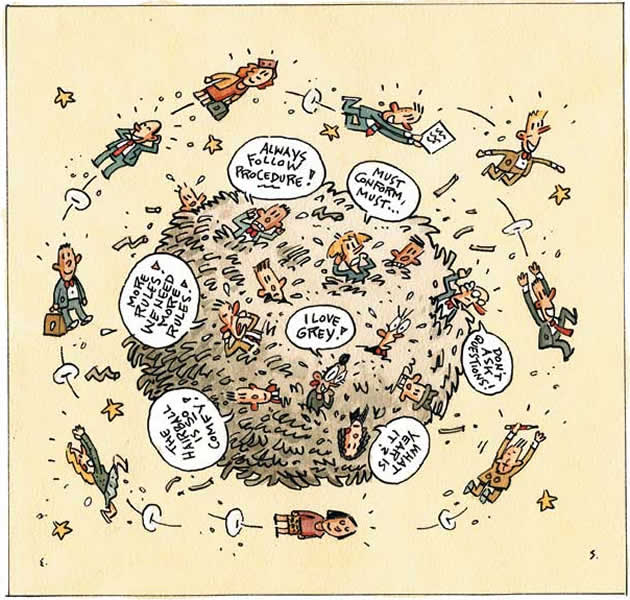The New Normal: DSRP Systems Thinking
 Hise Gibson
·
3 minute read
Hise Gibson
·
3 minute read
The corporation, as we know it today, arose out of World War II. With the United States transitioning into an actual industrial economy, the workforce became categorized into white- and blue-collar jobs.
The Past
White-collar jobs are typically associated with management, working predominantly in an office setting. Blue-collar jobs are typically associated with work inside a factory[1].
These different job types did not need to be co-located to gain operational efficiency. For example, General Motors' density of white-collar jobs could reside in Detroit. At the same time, the actual manufacturing of cars could occur in Indiana hundreds of miles away from the corporate headquarters. This creates a mental model of how we work today. People wake up at their homes and go to work that can be as far as a two-hour commute. Individuals will work for eight hours and then return home. This is the normal cycle for most adults, no matter the industry. Adults associate leaving their homes and going to a separate workspace as normal work operations, or some might call in most organizations a present culture. This automatically implies that if you work remotely, meaning you work from your home and not in the office, you are not present and are unable to be as collaborative.
The Natural Experiment
As of December 2019, the world was exposed to COVID-19 or the coronavirus. In March of 2019, the majority of offices in the United States were closed as a means to protect its most precious resource, its employees. Within a matter of days, organizations, like FaceBook, which had less than 20% of its 50,000-person workforce operating remotely, suddenly had the entire organization functioning in this manner. How is this possible? The acceleration of platforms, like Microsoft Teams, Zoom, BlueJean, GoToMeeting, and Cisco Webex, allowed organizations to shift and maintain productivity.
The Implications
This new normal has accelerated what might have occurred three to five years from now. This crisis has shed light on an organizational blindspot that the number of positions at the leadership or executive level may be oversaturated. Leaders are more technologically savvy and might need less support. The meeting that required business travel can occur virtually. The enterprise-level of many organizations have gained the necessary efficiencies to survive.
The Categories
I believe that this natural experiment that we are facing will create three distinct categories of organizations on the other side of COVID-19.
- Fully-Remote: The organizations that think that it can sustain the new, entirely virtual environment it has been thrust into.
- Back to the Future: The organization that will immediately go back to how it operated in November 2019 and assume that COVID-19 was a black swan event.
- Innovative Hybrid: The organization that leverages the lessons it has learned and recombines all the experiences and creates an entirely new normal or Hybrid Work Experience.
Unfortunately, not all organizations are going to be able to sustain an entirely virtual environment. The workforce it has may have been able to transition for this period, but might be ill-equipped to operate completely virtual. The reality is that people need a person to person interaction. There is a psychological side to working virtually that scholars have alluded to but have not had the opportunity to study in-depth.
Additionally, those organizations that immediately shift to pre-COVID-19 operations are discounting the workforce it desires to attract.
Most organizations have a bifurcated workforce. Those newly entering the workforce desire more flexibility while those more senior desire predictability, similar to the "Flinstone Cartoon," where all the work started when the pterodactyl crowed and ended promptly at 5.
The Bridge
Leveraging a Systems Thinking approach to the current environment will accelerate organizations to develop an innovative new normal as they come out of the COVID-19 reality. Organizations will gain critical insights through leveraging the DSRP Systems Thinking model that is imperative to moving to the innovative middle[2]. Dr. Cabrera explains that "innovation occurs at the 'in-between' in the interfaces, interactions, and connections" and has shown that RDSs (looking at the relationship—or the in-between space—as a distinct and systemic entity) are an "algorithm for innovation" (see also here and here). This is just one example of the types of thinking that organizations must do.

Figure 1: Systems map showing an RD (relationship distinction) that could be converted into an RDS (relationship distinction system). Organizations will need to know what its RDS looks like to thrive in the future.
By clearly understanding the distinctive difference between how they are operating now versus in December 2019, those organizations that take a tactical pause amid the crisis will create the necessary Tradespace to make better strategic decisions while simultaneously executing at the tactical level well.
References and Footnotes
[1] https://www.linkedin.com/pulse/whats-types-collar-workers-hassan-choughari/
[2] https://blog.cabreraresearch.org/the-four-simple-rules-of-systems-thinking/
.png?width=150&height=150&name=CRL%20GOAT%20Logo%20(4).png)


